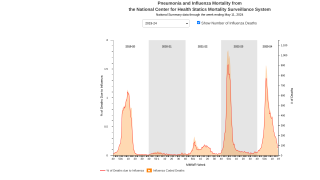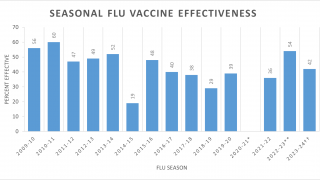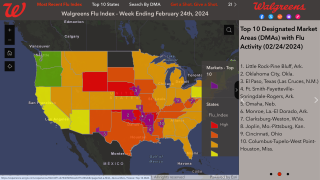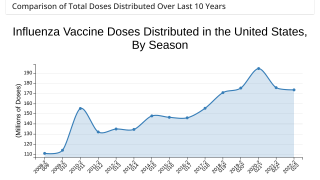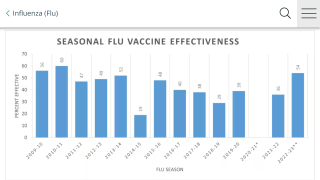Now is a Good Time to Get This Year’s Flu Shot

While most of the USA remains focused on the COVID-19 pandemic, we need to also be aware of the 2020-2021 influenza season in the Northern Hemisphere that is fast approaching.
Influenza (flu) viruses typically spread each fall and winter, with activity peaking between December and February, said the U.S. Food and Drug Administration (FDA) in a digital statement published on September 30, 2020.
Every flu season is different, and the substantial health impacts can vary widely from season to season, with some flu seasons being worse than others. Your best defense is vaccination, which provides important protection from flu and its potential complications.
The task of producing a new vaccine for the next flu season starts well before the current season ends. For the FDA, it’s a year-round initiative.
‘Getting vaccinated now can lower your chances of getting the flu,’ states the FDA.
The US Centers for Disease Control and Prevention (CDC) estimate that during the 2018-19 flu season, vaccination prevented 4.4 million flu illnesses, 58,000 hospitalizations, and 3,500 flu-related fatalities.
COVID-19 and Flu
It’s likely that flu viruses and the virus that causes COVID-19 will circulate together this fall and winter. The flu vaccine will not prevent COVID-19.
The flu vaccines for the 2020-2021 flu season are approved by the FDA for the prevention of influenza disease, so getting vaccinated can help keep you out of the doctor’s office and preserve health care resources for patients with other diseases and medical conditions, including COVID-19.
The FDA plays a key role in ensuring that safe and effective flu vaccines are available every flu season. Flu viruses are spread by droplets when people infected with the flu cough, sneeze or talk.
Flu may also be spread when a person touches a surface or object that has flu viruses on it and then touches their own mouth, nose, or eyes.
It’s best to get immunized early in the flu season.
The CDC recommends that adults and children older than 6 months should get a flu vaccine by the end of October. Even if you wait until after October, go get your flu vaccine. It’s still beneficial because it can protect you for the remainder of the flu season.
If you have already been sick with the flu this season without getting vaccinated, a flu vaccine is still recommended, because the flu vaccine prevents three or four different flu virus strains, depending on which vaccine you receive.
Presumably, you were infected with one type of flu virus strain, so the flu vaccine would still offer protection against the flu virus strains that you haven’t already had.
A Flu Shot Is the Best Prevention
The flu vaccines approved by the FDA provide important benefits. Flu seasons and their severity are unpredictable. Annual vaccination is the best way to prevent influenza in people ages 6 months and older.
An annual vaccination to prevent flu is the best way to reduce the risk of getting the flu and spreading it to others. When more people get vaccinated, it is less likely that the flu viruses will spread through a community.
The vaccine typically changes each year and contains flu virus strains that are expected to be prevalent during the upcoming flu season. The effectiveness of influenza vaccines varies depending on several factors, such as the age and health of the recipient, the types of circulating influenza viruses, and the degree of similarity between circulating viruses and those included in the vaccine.
The flu vaccine will trigger your immune system to produce antibodies that can protect against influenza disease — it will not make you sick with the flu. It can take about two weeks after vaccination for antibodies to develop in the body, which is an important reason to get your flu vaccine before flu activity starts.
Why We Need New Flu Vaccines Every Year
According to the FDA’s Office of Vaccines Research and Review, there are several reasons a new flu vaccine must be made each year.
Flu viruses can change from year to year, so the vaccine is updated to protect against new virus strains that are expected to circulate in the United States. The vaccine needs to include influenza virus strains that most closely match those in circulation for the influenza season.
In addition, the protection provided by the flu vaccine a person received in the previous year will diminish over time and may be too low to prevent influenza disease into next year’s flu season.
Each February, before that year’s flu season ends, the FDA, the World Health Organization (WHO), the CDC, and other public health experts collaborate on collecting and reviewing data from around the world to identify the flu viruses likely to cause the most illnesses during the next flu season.
Following that process, the FDA convenes its vaccines advisory committee, consisting of outside experts, to provide advice to the FDA on the upcoming U.S influenza season. Committee members discuss the WHO recommendations and consider which flu viruses are expected to circulate in the United States.
They also review data about which flu viruses have caused illnesses in the past year, how the viruses are changing, and disease trends for the USA. The FDA takes that information into account before it selects the virus strains for FDA-licensed manufacturers to include in their vaccines for use in the USA.
The closer the match between the virus strains chosen for the vaccine and the circulating strains causing disease during flu season, the better the protection that the flu vaccine provides. Although the vaccine and viruses may not be an exact match in some years, that does not mean the vaccine is not benefiting people.
‘We know from past studies that the vaccine can still provide enough protection in people who received it to help make their illness milder or prevent flu-related complications,’ says the FDA.
The Flu Vaccine Is Safe
To ensure that the flu vaccine is safe, effective, and of high quality, the FDA prepares and provides reagents to manufacturers that they need to make their vaccine and to verify its identity and potency. The FDA also inspects manufacturing facilities regularly and evaluates each manufacturer’s vaccine annually before it can be approved.
But, the FDA’s oversight doesn’t end there.
After manufacturers have distributed their vaccines for use by the public, the FDA and CDC scientists work together to routinely evaluate reports submitted by companies, health care providers, parents, and patients to the Vaccine Adverse Event Reporting System (VAERS) of health problems that may be associated with a vaccine.
And the CDC maintains the Vaccine Safety Datalink (VSD), which provides nearly real-time monitoring of people who are vaccinated, in collaboration with (9) integrated healthcare organizations.
The FDA has approved numerous vaccines for the prevention of influenza.
But if you do get the flu, there are several FDA-approved antiviral drugs recommended by the CDC for use against circulating influenza viruses. These drugs work best if started soon after the onset of symptoms (within 48 hours).
For more information on vaccines, immunization, and where to get vaccinated, visit vaccines.gov.
PrecisionVaccinations publishes research-based influenza news.
Our Trust Standards: Medical Advisory Committee















